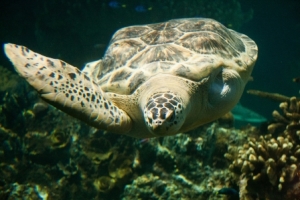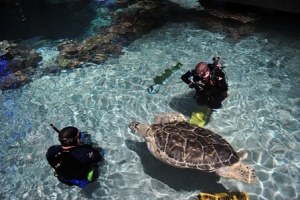Calypso the Three-Flippered Sea Turtle
Do you remember our post on Junebug, the sea turtle with three flippers? Well, today we have a guest post all about Calypso! Calypso is also a sea turtle with three flippers that lives at the National Aquarium in Baltimore, Maryland. We were lucky enough to talk with Jackie who takes care of Calypso.
Q: What do you do at the National Aquarium?
A: I am a Senior Aquarist and Dive Safety Officer.
Q: How many sea turtles do you have at the National Aquarium?
A. We currently have 5 sea turtles here at National. Calypso, a green sea turtle, is our only permanent resident sea turtle. We also have a head-start loggerhead and three holdovers from the last rescue season.
Q: What made you want to work with animals like sea turtles?
A. I have had strong interest in all animals since I was a child and still can hardly believe that I am lucky enough to work with amazing animals like Calypso.
Q: What is Calypso’s story?
Calypso was found cold-stunned on the coast of Long Island Sound in November of 2000. She was rescued by the Riverhead Foundation .When they brought her in, she had an infection in her left front flipper. They were unable to successfully treat it and had to amputate the flipper. At that point in time, it was thought that sea turtles with only three flippers could not survive in the wild, so she was declared unreleasable. The Riverhead Foundation donated her to us in 2002.
Q: Would Calypso be able to survive in the wild?
A. She has been in human care for a long time, so I am not sure how well she would do at this point.
Q: To your knowledge, are there many sea turtles in the wild with missing flippers? Are their chances of survival lower?
A. I have personally observed two sea turtles in the wild that only had three flippers. Both of them seemed to be doing fine, but both were missing rear flippers. Calypso is missing a front flipper.
Q: What is personally your favorite part about working with Calypso?
A. My favorite thing about working with Calypso is having her interrupt our less exciting husbandry jobs (like gravel vacuuming) for a quick shell scratching break. She always seems to want attention just when I am ready for a break too.
Q: Is there anything else you’d like to share?
A. I often get asked what people can do to help sea turtles in the wild and there are lots of things that people can do. The easiest and one of the best actions people can take is to refuse, reduce, reuse, and recycle plastics. Give up your plastic shopping bags and replace them with reusable ones.
Here at our Aquarium at Fort Fisher, our loggerhead hatchlings are still growing! This week, Turtle A is 169.0 grams and 9.6 cm and Turtle B is 137.3 grams and 8.6 cm. For more information on what to do with those numbers, please check out our lesson: Hatchling to Yearling. For more information on Calypso at the National Aquarium, visit here.














